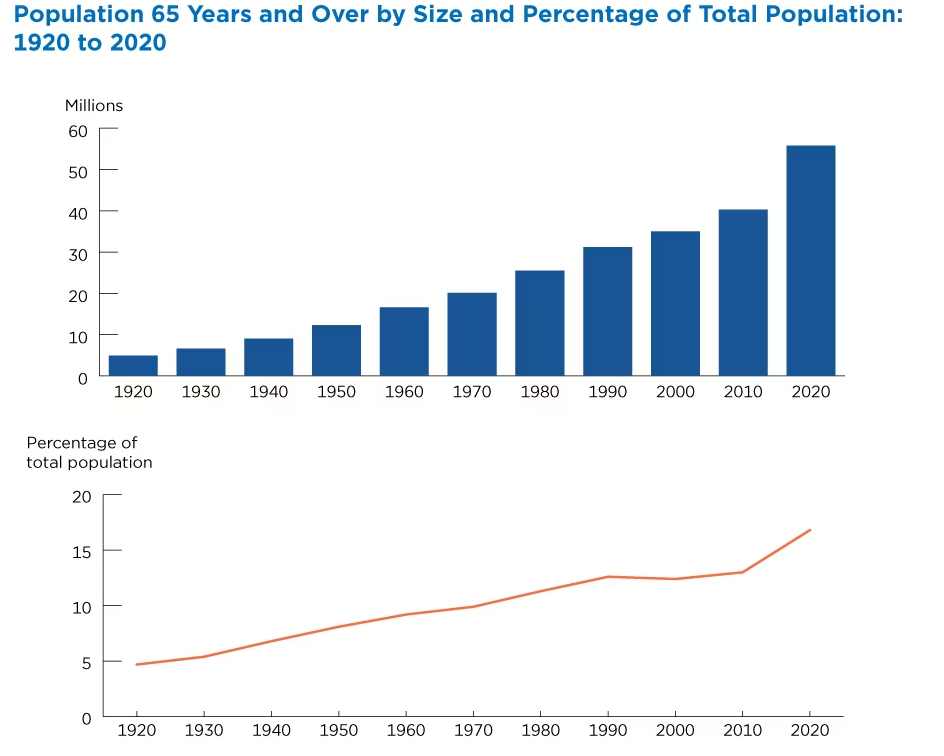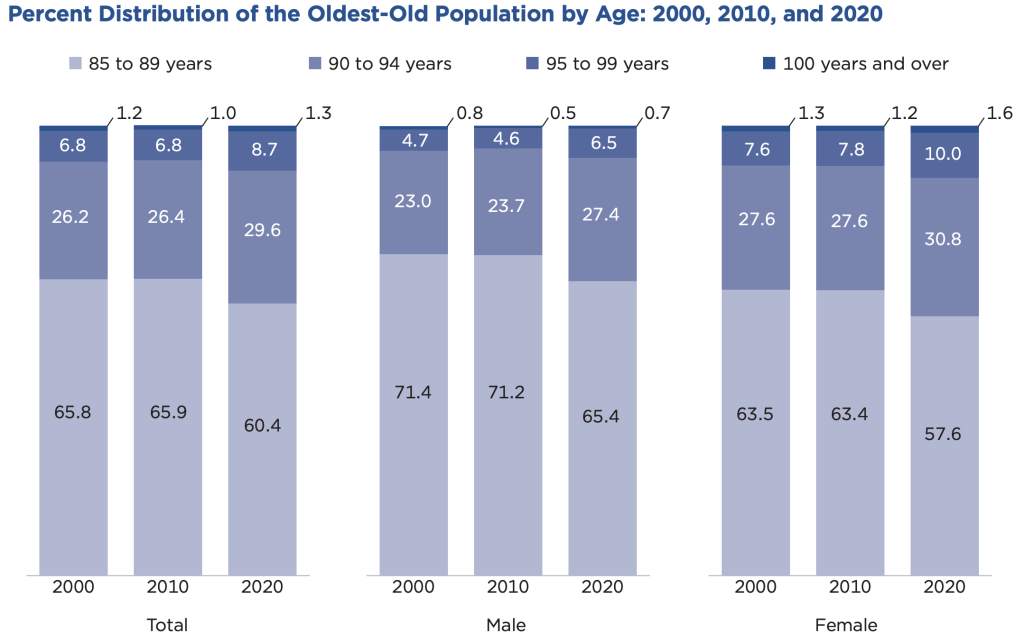Introduction
We are living in unprecedented times. The United States is an aging nation. For over a century, the U.S. has experienced exponential demographic growth in the number and proportion of persons aged 65 and older. The previous decade between 2010 to 2020 represented the fastest growth period ever in the number of Americans who turned 65 and reached late adulthood. In fact, the older adult population increased at five times the rate of the total population. Nearly 56 million or roughly 17 percent of the U.S. population is currently comprised of person over 65 years of age. This amounts to 1 in every 6 Americans alive today who are older adults. Most of this growth can be attributed to the aging of the Baby Boomers (persons born between 1946-1964) who began turning 64 in 2011. By the end of 2029, all remaining and surviving members in this large birth cohort will be 65 and older.

It is projected that persons in this cohort will continue to live healthier and longer lives with a sizeable proportion living well past 75+ years. A greater number are also expected to reach their 100th birthday in the coming decades. This is evident based on comparative census tract data from 2000, 2010, and 2020. Persons 90 or older have come to account for a greater proportion (39.6%) of total population of persons over the age of 85, this is particularly true among very old women where 57.6% are currently in their 80’s, whereas the remaining 42.4% are 90 years or older. (See Figure 2)

Aging is a also global issue reality. While the United States continues to experience historic growth in the older adult population, many countries around the world are considered to be older. Nations such as Japan and Italy are often deemed as “old” nations on the basis that older adults account for nearly a quarter or more of their population. Older adults make up 28.5% of Japanese residents; whereas around 23% of all residents in Italy are aged 65 or older. (See Figure 3)

We live in an aging society and world. Yet, the reality of human aging is commonly disregarded. Old age is something perceived as well off into the future rather than immediate. It is often considered as something that can happen; rather than a phenomenon that will happen. You probably do use the topic of aging to start to introduce yourself to a stranger or strike a conversation with a friend. In addition, aging is probably not a focal point of discussion around most family dinner table. It is more likely that an occasional comment is made regarding the physical appearance of a wrinkle or gray hair, or complaint about an ache or pain or difficulty remembering the of a person and place; or general acknowledgement regarding how to finance one’s future retirement, housing, and long-term care. Nonetheless, aging is a process we commonly observe in others but put off when it comes to “self.”
According to the American Psychological Association (2017), there is fine balance between what persons come to believe about aging and what is actually real about it. There are several prevailing myths and realities which most persons must come to realize:
- Myth: All older adults are alike. Reality: Older adults represent a diverse population. The demographic composition of older adult population in the United States has undergone a dramatic transformation over the last two decades. For example, nearly 25% of persons, aged 65 and older, are members of racial or ethnic minority populations. Persons of Hispanic origin now represent approximately 10% of the older adult population. Furthermore, the population of older immigrants in the U.S. has increased by over 70% since 2000. Finally, the estimated number of older adults who identify as lesbian, gay, bisexual, or transgender is expected to double in the next two decades.
- Myth: Most older adults live in nursing homes. Reality: Only 5% of adults live in a nursing home at any one give time. The percentage of older adults who reside in a nursing home increases with age ranging from around 4% among persons 65-84 years of age to under 14% among persons aged 85 and older. Otherwise, the vast majority of older adults reside in the community. It is likely you may even know several older adults who live in your own apartment complex, neighborhood, or community.
- Myth: Older adults are socially disengaged and are lonely. Reality: Many older adults continue to work or volunteer after turning 65. According to the American Association of Retired Persons (AARP), around 20% of older adults continue to work past their retirement age. Furthermore, the U. S. Bureau of Labor Statistics has projected that persons over 65 years of age will account for faster annual rates of labor force growth than any other age group in the coming years. In addition, Baby Boomers have the highest participation rate (59%) of unpaid informal volunteer work compared to other cohort groups, including Gen X, Millennials, and Gen Z. Multiple research investigations over the past several years continue to indicate that young adults spend twice as many days feeling lonely, disconnected, and isolated from others than those who are older in age (Child, 2019; Hawkley, 2022)
- Myth: Older adults have little to no interest in romantic intimacy. Reality: Many older adults continue to enjoy a physical and emotionally active love life. Nearly 14% of single older adults, aged 65 and older, are in a romantic or dating relationship. Over 25% of adults over the age of 50 actively use an online dating platform, site, or app (Pew, 2023). Most interesting, a University of Michigan national poll on healthy aging reported an estimated 40% all persons between age 65 to 80 are currently sexually active and interested in regular physical intimacy.
- Myth: You cannot teach an old dog new tricks. Reality: Older adults can learn new skills and ways of doing things. Despite normative changes in cognition and intellectual processing, older adults can still do many of the same things they have enjoyed their entire lives. Plasticity of the brain allows older adults to learn new skills, form new memories, and improve vocabulary and language skills. Older adults show significant cognitive improvements from the lifelong learning of new skills and can often learn and perform the skill as efficiently as a young adult. This is particularly true when older adults are given a little extra time to learn, practice, and acquire an unfamiliar skill.
- Myth: All older adults eventually have dementia or Alzheimer’s Disease. Reality: Risk of dementia is largely a combination of genetics, environmental exposure, and lifestyle behaviors. Although it is true that risk of being clinically diagnosed with dementia of the Alzheimer’s types increases with age, most persons will likely be impacted by normative age-related changes in memory functioning. According to the Alzheimer’s Association, approximately 73% of all persons diagnosed with Alzheimer’s Disease are 75 years of age or older. Older Black American are twice as likely to be diagnosed with Alzheimer’s or other dementias than their older White counterparts. Only 1 in every 9 persons aged 65 and older or 10.7% are ever-diagnosed with Alzheimer’s Disease in their lifetime. Persons who engage in a sedentary lifestyle, smoke, and eat an unhealthy diet across the adult years put themselves at a greater risk for dementia or Alzheimer’s Disease at an older age. Otherwise, most persons will not be severely if ever impacted by dementia to the point of requiring clinically intervention or treatment.
Many persons struggle to overcome the myths of aging. When we reach a point where we can no longer deny the signs, symptoms, or realities of being “old” and the inevitability of mortality, aging becomes personal. For many, the realities of aging become most obvious by the time we reach our 40’s, 50’s, or 60’s and remain with us to the end of life. We start to seek new ways to better manage our physical health and care for our bodies. We desire new approaches to sustain a cognitivel and intellectual edge. We desire to retain a sense of identity, inclusion, and belonging within family and to community. There is great variability among persons who are successful in achieving physical, cognitive, and social vitality in old and very older age. Some will succeed, and others will slide. Most of us are destined to experience some level of challenge or setback in our own aging process that will require resilience. It may be said that we must first fail before we can succeed. Nonetheless, most humans have what may be called “grit,” or the ability to remain courageous amid the unfamiliar or unknown, to persevere despite adversity and loss, and to regain a passion for living in the second developmental half of life. This textbook is designed to provide insights by which all persons can increase their awareness, knowledge, and understanding of the biological, psychological, and social change and stability that comes with aging and being human.
References
Brown, S. L. & Shinohara, S. K. (2013). Dating relationships in older adulthood: A national portrait. Journal of Marriage and Family, 75(5), 1194-1202. https://doi.org/10.1111%2Fjomf.12065
Child, S. T., & Lawton, L. (2019). Loneliness and social isolation among young and middle-aged adults: Associations of personal networks and social participation. Aging & Mental Health, 23(2), 196-204. https://doi.org/10.1080%2F13607863.2017.1399345
Hawkley, L. C., Buecker, S., Kaiser, T., & Luhmann, M. (2022). Loneliness from young adulthood to old age: Explaining age differences in loneliness. International Journal of Behavioral Development, 46(1), 39-49. https://doi.org/10.1177%2F0165025420971048

